Demodex Mites in Eyelashes: The #1 Menace of Rosacea Symptoms + Natural Treatments
Does everybody have eyelash mites? Yes, but…
Did you know that people with rosacea can have over 15 times more Demodex mites than those without it? 1 These tiny mites, living in your eyelash follicles, are usually harmless and even help break down oils and dead skin cells. But for those with rosacea, their overgrowth can trigger inflammation, redness, and discomfort.
Here’s a simple way to picture it: imagine a postage stamp-sized patch of skin. For someone without rosacea, that area might have less than one mite—hardly noticeable. But for someone with rosacea, it could have many more mites. In fact, studies have shown a single pore housing hundreds of mites! Now imagine that load across your entire face. No wonder rosacea-prone skin feels so inflamed and reactive!
The key to managing this isn’t just about addressing the mites—it’s about understanding why they thrive in rosacea-prone skin in the first place. That’s where a holistic approach can make all the difference.
What Are Demodex Mites in Eyelashes?
The microscopic organisms known as Demodex mites naturally live in hair follicles, especially around your eyelashes. There are two main types of mites that affect humans: Demodex folliculorum and brevis. They feed on dead skin and oils, playing a small role in keeping your skin’s microbiome balanced. For most people, they go unnoticed. But if you have rosacea-prone skin, these mites can cause more harm than good. Imagine that you’re having an allergic reaction to something that lives naturally on your skin, and now you’re starting to get the picture.
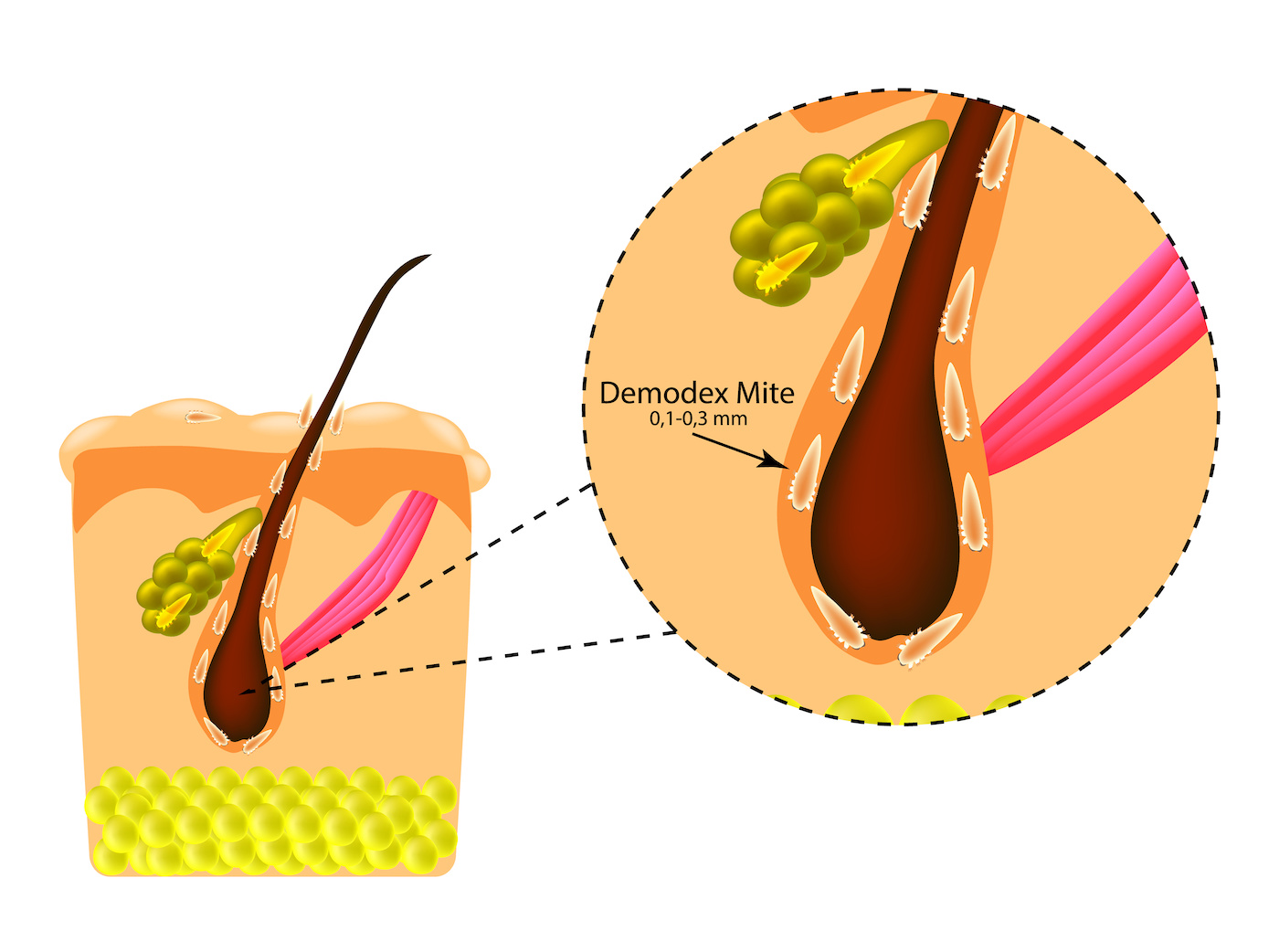
When Demodex mites overpopulate, or even when they die, they release bacteria like Bacillus oleronius that can irritate sensitive skin. This can trigger redness, dryness, and irritation—common struggles for those with rosacea, a chronic inflammatory disease. So, while they’re a normal part of your skin, keeping their numbers balanced is key to calming flare-ups and maintaining healthy skin. 1
The Life Cycle of Demodex Mites:
- Lifespan: Each Demodex folliculorum mite lives for about 14 to 16 days, spending its life in hair follicles and sebaceous glands.
- Reproduction: Mites lay eggs in hair follicles, and larvae mature into adults within a week.
- Die-Off Process: When mites die off, they release bacteria and toxins, which can irritate sensitive skin and worsen rosacea symptoms. In fact, rosacea sufferers often have an allergic reaction to the bacteria.
- Temporary Flare-Ups: Treatment may trigger short-term redness and discomfort as mites die off throughout their life cycles, but consistent care can lead to improvement.
⚠️ Transmission Risks
Demodex mites are primarily spread through close contact. Populations tend to increase in older adults with increased oil production, making eyelashes more vulnerable to infestation. 3
Exciting New Research:
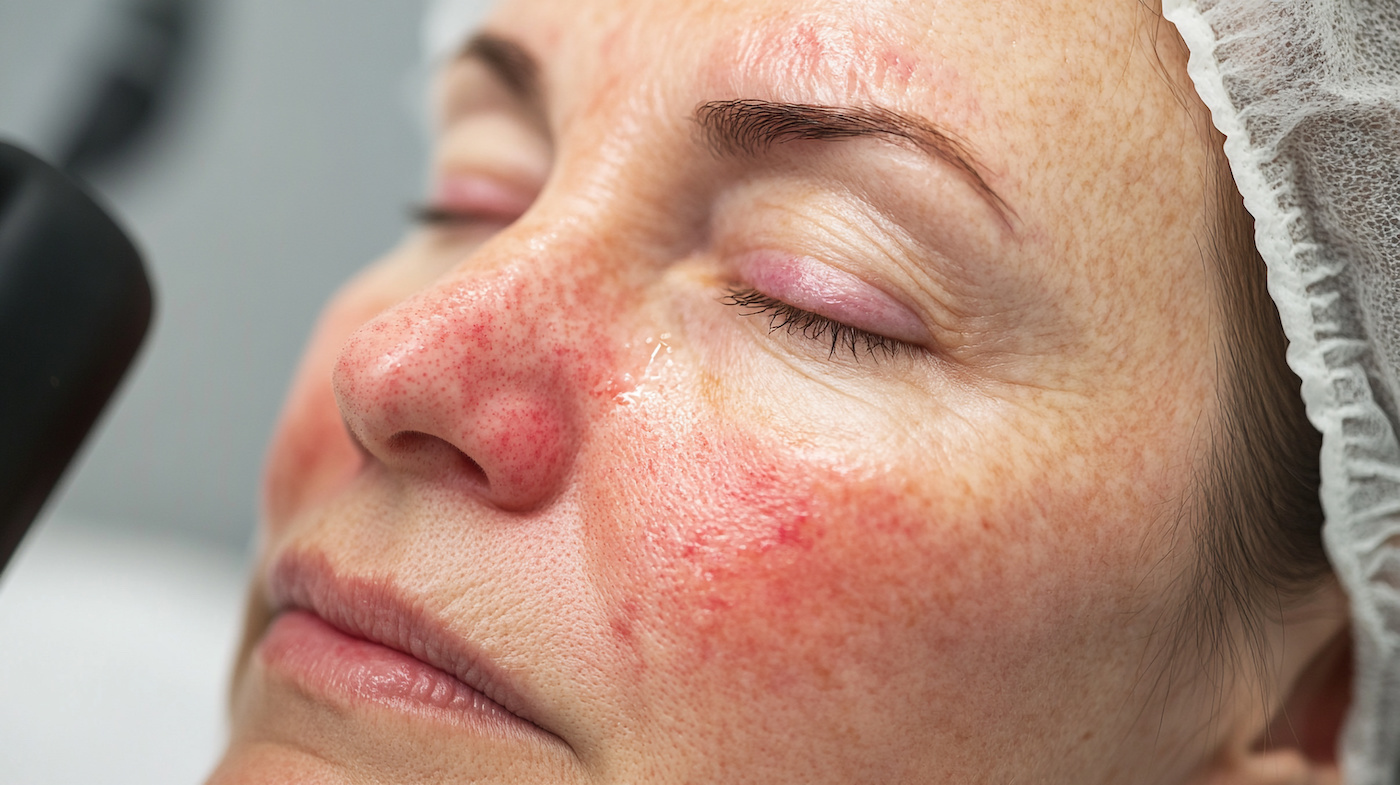
YES, Demodex Mites in Eyelashes Worsen Rosacea
Studies now confirm what we’ve been seeing in practice: these tiny mites can play a significant role in triggering rosacea symptoms.
When I first started The Rosacea Method in 2019, no one was talking about Demodex mites and their connection to rosacea. There just wasn’t enough research at the time. But things have changed! This is incredibly exciting because it means we’re uncovering ROOT CAUSES that make a real difference in managing rosacea. -Dr. Tara O’Desky
Here’s what the latest research shows:
- How Common Are Demodex Mites in Rosacea? About 58.5% of people with rosacea have detectable levels of these mites, compared to just 19.5% in people without rosacea. That’s a big difference! 4
- Higher Mite Density in Rosacea-Prone Skin: For someone with rosacea, a small patch of skin the size of a postage stamp can typically host 10–11 mites, compared to less than one mite in people without rosacea. 5
- Why They Worsen Rosacea: When Demodex mites die, they release bacteria like Bacillus oleronius. This can create a chain reaction of inflammation, leading to redness, swelling, and irritation, especially in sensitive areas like the eyelashes. 6
- Different Rosacea Types Are More Affected: If you have papulopustular or erythematotelangiectatic rosacea, you’re even more likely to have higher mite levels—nearly 63% of people with these rosacea types show increased mite populations. 7
It’s thrilling to see research finally catching up. For years, Demodex mites were often overlooked in conversations about rosacea, but we now know they’re a key factor. By understanding and addressing their role, we’re uncovering the root causes of rosacea and moving closer to lasting relief.
3 Key Takeaways from the Research
- Demodex Is More Common in Rosacea: Over half of rosacea patients have these mites in higher numbers, especially around sensitive areas like the eyes.
- More Mites = More Irritation: Rosacea skin hosts up to 10 times more mites, and when they die, they release bacteria that trigger inflammation. 8
- Managing Mites Can Help: Keeping mite populations under control with pharmaceutical treatments or natural based products can reduce symptoms and irritation.
This research explains why mites matter, but it doesn’t tell the whole story. Dr. Tara shares why rosacea patients often feel these effects more strongly—and what you can do about it.
🌸 Pro Tip from Dr. Tara: I’ve seen incredible results when people address both internal and external rosacea triggers. By reducing mite populations with natural treatments and decreasing your inflammatory processes through diet and gut health, you can break the cycle of flare-ups and possibly even reverse rosacea once and for all.
So Why Do Mites Affect Rosacea Patients More?
Rosacea-prone skin reacts to Demodex mites almost like an allergy. While these tiny mites are harmless for most people, the combination of sensitive skin and an overactive immune response in rosacea patients creates the perfect storm for irritation.
- Increased Sensitivity: With a weaker skin barrier, rosacea-prone skin is more vulnerable to the waste products released by Demodex folliculorum, leading to noticeable flare-ups.
- Inflammatory Overreaction: For people with rosacea, the immune system often mistakes these mites as a serious threat, sending immune cells to the area and causing redness, swelling, and discomfort.
- The Vicious Cycle: Rosacea creates the ideal conditions for Demodex mites to thrive: a weakened skin barrier, excess oil production, and warmer skin from flushing. As mite populations increase, they trigger an immune response that worsens inflammation and symptoms. This inflammation, in turn, encourages further mite overgrowth, keeping the cycle going. 9
Breaking this cycle requires a holistic approach: managing mite populations externally and addressing internal triggers like inflammation, gut health, and overall skin resilience.
What Are the Symptoms of Demodex Mite Overgrowth?
Demodex mites can cause a variety of symptoms, particularly in cases of ocular rosacea. Recognizing these early signs can help you take action and find relief.
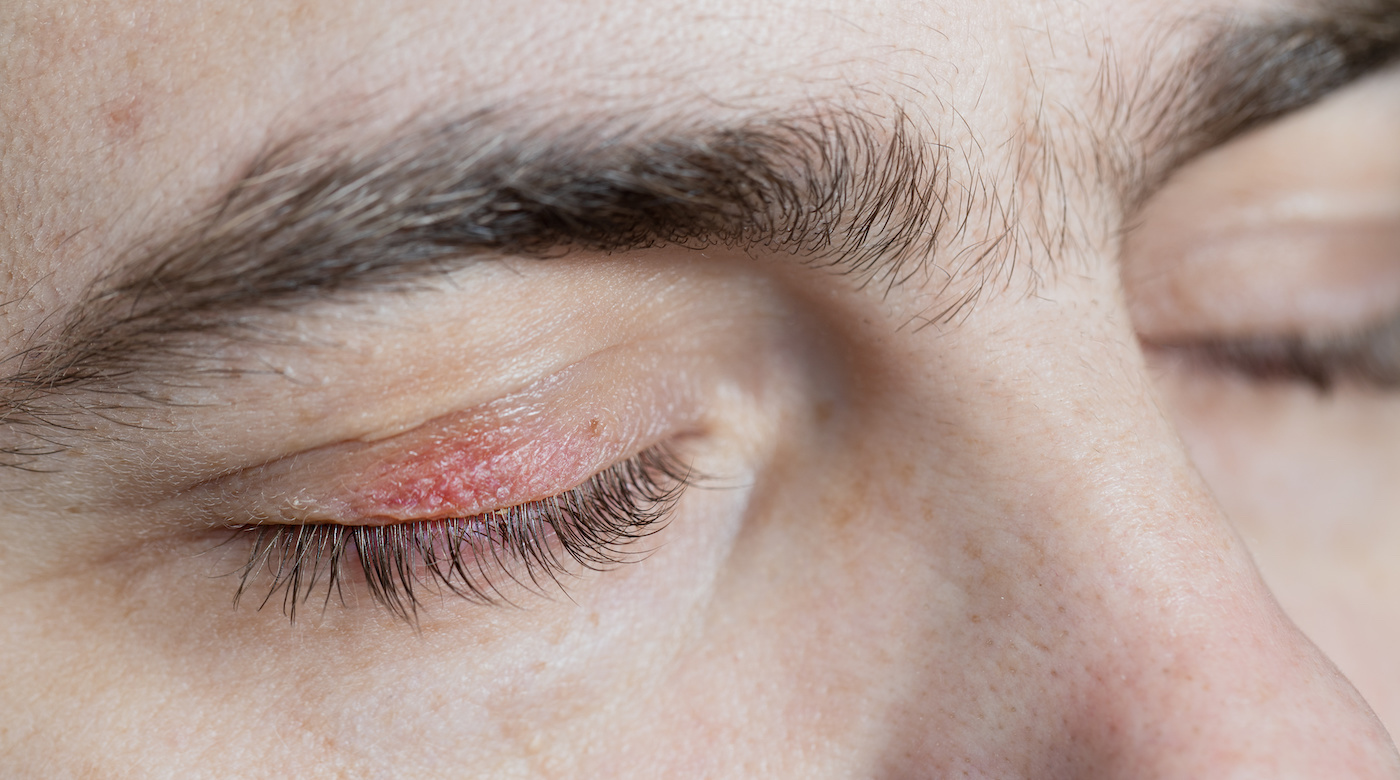
5 Common Eye Mite Symptoms to Watch For:
- Red, itchy, or watery eyes: Persistent redness or itching may indicate mite activity around the eyes.
- Crusty eyelids upon waking: Waking up with crusty or sticky eyelids is a common sign of Demodex overgrowth.
- Gritty sensation: Many with ocular rosacea describe feeling like there’s sand or grit in their eyes.
- Redness and Pustules: Raised pustules or red areas on the eyelids are linked to Demodex blepharitis (eyelid swelling).
- Thickened Eyelids and Lash Loss: Thick, scaly eyelids or lash loss can signal that mites disrupt hair follicles.
Your eye health matters, and you deserve to feel comfortable and confident.
Additional Signs Related to Mite Overgrowth
Some people also report:
- Crawling sensation: A subtle, unsettling sensation of movement on the face, especially near the eyes.
- Sensitivity to light: Inflamed skin around the lashes can lead to increased sensitivity to light (photophobia).
- Recurrent eye infections: Blepharitis, conjunctivitis, or styes may occur more frequently.
📝 Pro Tip: If you notice these symptoms, consult a dermatologist or eye specialist for evaluation and treatment. Early intervention can prevent further complications and improve your comfort.
Natural Remedies Backed by Research
While mites are a natural part of the skin’s microbiome, their overgrowth can worsen rosacea symptoms. Dr. Tara emphasizes combining gentle external treatments with internal healing to achieve the best results—an approach she developed while successfully healing her own ocular rosacea.
Sometimes, simple, natural solutions are all you need to make a big difference. These remedies are gentle on sensitive skin and backed by research. Keep in mind that any new product can be extremely irritating to rosacea-prone skin, so always talk to your doctor before trying any new product on your skin or eyes.
- Tea Tree Oil Cleansers: Tea tree oil is a proven, natural solution for reducing mites. Just be sure to use a diluted version or a specially formulated tea tree cleanser to avoid irritation. 10 Tea tree oil can be extremely irritating to rosacea-prone skin, so always talk to your doctor before trying any new product on your skin or eyes.
- Sulfur-Based Products: I’ve been recommending sulfur-based creams and soaps for years. They are proven to reduce mite density and not only do they reduce mite density but also help soothe inflamed skin—a win-win for rosacea-prone skin. 11 Keep in mind, sulfur can be extremely irritating to rosacea prone skin, so always talk to your doctor before trying any new product on your skin or eyes.
- Warm Compresses: Don’t underestimate the power of a warm compress! Applying a compress at 104°F (40°C) for 5–10 minutes helps unclog oil glands, making it harder for mites to thrive. 12
It’s so encouraging to see research validating these natural approaches—proving that sometimes, the simplest methods really are the most effective. Just remember to patch-test any new products and consult with a provider if you’re starting a new routine.
Eyelid Hygiene and Daily Practices
Consistent eyelid hygiene is one of the simplest yet most effective ways to manage mites and reduce rosacea symptoms. Incorporate these habits into your routine:
- Start with a Warm Compress: Loosen debris and oils with a warm washcloth or reusable compress.
- Cleanse Your Lashes: Use a gentle cleanser to clear away oils and residue.
- Don’t Skip Makeup Removal: Always remove makeup before bed to prevent oils from building up. Use your own tools to avoid introducing bacteria.
A Holistic Approach to Managing Demodex
Managing rosacea isn’t just about what you put on your skin—it’s about how you care for your body as a whole. Internal health plays a key role in calming rosacea symptoms and reducing your skin’s sensitivity to Demodex mites.
While topical treatments can reduce mites, addressing internal health is key for lasting relief.
- Internal Healing: Focus on gut health, reducing systemic inflammation, and making dietary adjustments to calm rosacea triggers.
- Daily Wellness Practices: Proper hydration, stress management, and balanced nutrition can support your skin’s resilience over time.
By combining external care with internal healing, you can break the cycle of inflammation and support long-term skin health.
Topical options for demodex mites can be helpful, but should not be used long term. Ideally, you want to get to a place where your body no longer reacts to the mites. Then you won’t need a topical treatment!
Medical Demodex Treatments to Consider
For those dealing with more persistent symptoms, medical treatments can complement your existing routine to target Demodex mites effectively. After a proper diagnosis, a dermatologist or eye doctor may recommend:
- Ivermectin Cream: Targets mites directly and helps calm inflammation.
- Topical Antibiotics: Useful if there’s a bacterial infection caused by mite activity.
- Oral Medications: For more stubborn cases, your doctor might suggest oral antiparasitic or anti-inflammatory pharmaceuticals.
While topical treatments can help manage Demodex mites, true, lasting relief comes from healing internally. A balanced diet, hydration, and stress management create the foundation for healthier, less reactive skin, complementing topical care for better long-term results.
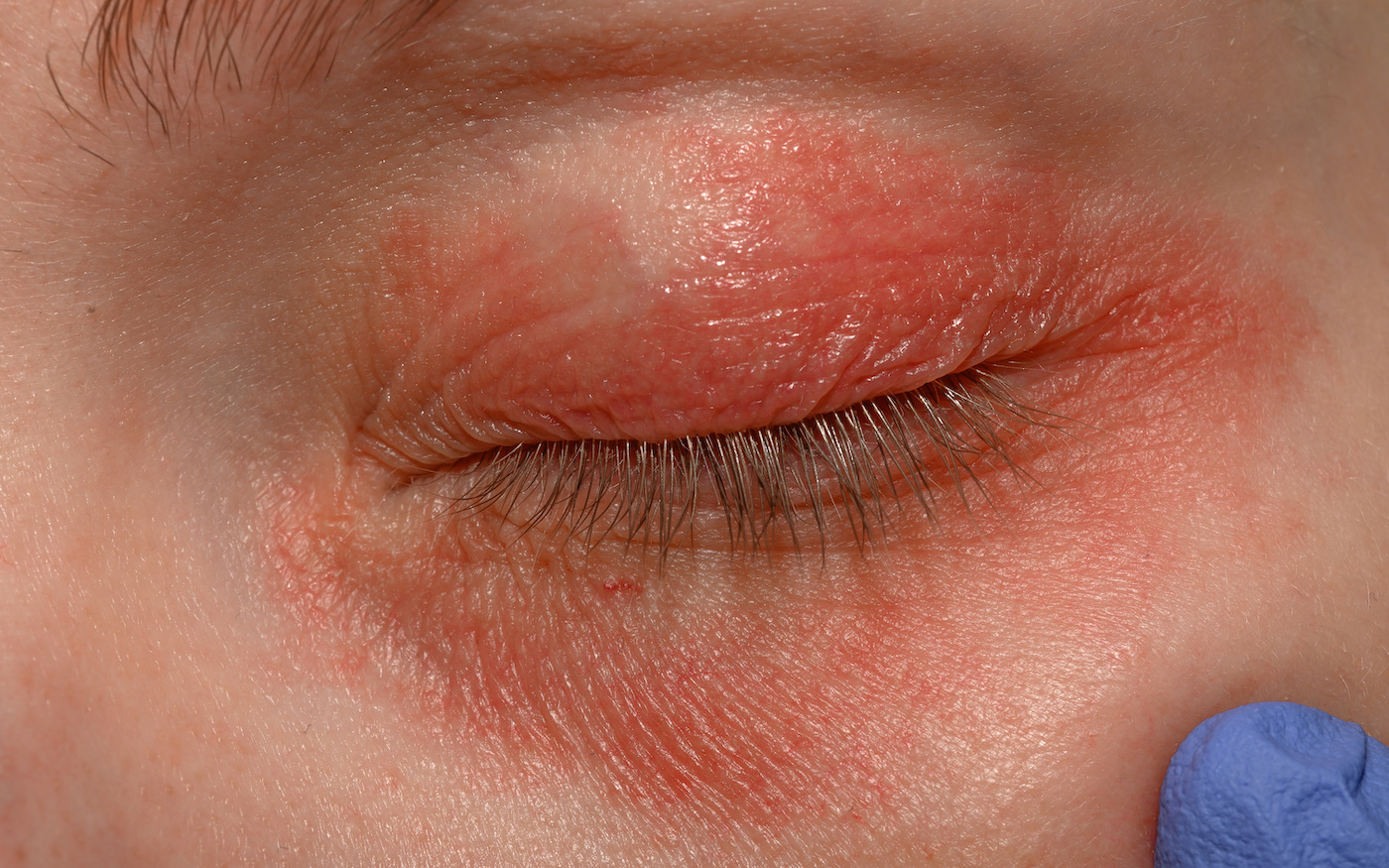
Final Thoughts: How Holistic Care Supports Healthy Skin and Manages Demodex Mites in Eyelashes
Managing Demodex mites and rosacea symptoms isn’t just about what you put on your skin—it’s about creating a daily routine that works for your whole body. While mites aren’t the root cause of rosacea, they can make things worse, which is why a thoughtful combination of good hygiene and internal care is so important.
Dr. Tara often reminds her clients that true, lasting relief comes from addressing both the outside and the inside. By nourishing your skin from within—through a balanced diet, gut healing, addressing toxic overload and managing stress—you can calm inflammation and help your skin become less reactive to triggers like Demodex mites. When you pair this with gentle, consistent eyelid hygiene, you create a strong foundation for long-term results.
Here’s What to Remember:
- Take a Holistic Approach: It’s not just about treatments—healing from the inside out and supporting your skin’s natural defenses is key.
- Stay Consistent: A little effort every day goes a long way. Sticking to your routine can help keep flare-ups in check and improve your skin over time.
Small, consistent steps can make a big difference. By caring for both the inside and outside, you can feel more confident and in control of your skin. With balance and patience, clearer, calmer skin is absolutely possible.
Frequently Asked Questions about Demodex Mites in Eyelashes
-
What kills Demodex mites on eyelashes?
Over-the-counter products (specifically meant for eyes) containing tea tree oil or hypochlorous acid, such as OCuSOFT Oust or Cliradex, are often effective for reducing Demodex mites. These cleansers help remove oils and collarettes on the lid margin, where mites thrive. NEVER put any product on your eyes which was not intended for use on your eyes, as you can permanently burn or scar your delicate skin.
-
How do you know if you have Demodex mites in eyelashes?
Symptoms of Demodex mites in eyelashes include red or dry eyes, swollen eyelids, sticky or crusty lashes, itching, burning, and some patients report a gritty sensation in the eyes. In some cases, mites can damage the oil glands along the eyelids, leading to further irritation and dryness.
-
Can you feel Demodex mites crawling?
Some people report a crawling sensation on the skin, especially near the lid margin, when Demodex mite activity increases. This is often accompanied by itching and irritation.
-
What happens if Demodex is left untreated?
If left untreated, Demodex overgrowth can worsen conditions like rosacea, leading to redness, inflammation, and pustules. Untreated Demodex may also damage the pilosebaceous units and contribute to ongoing skin irritation or eyelid conditions like blepharitis.
-
How do you know if you have eyelash mites?
Common signs of eyelash mites, such as Demodex, include red or swollen eyelids, sticky or crusty lashes, itching, and a gritty sensation in the eyes. A buildup of collarettes at the base of the lashes is another indicator. A doctor may use a slit lamp exam to confirm their presence.
-
Are eyelash mites harmful?
Eyelash mites, like Demodex, are typically harmless in small numbers. However, when they overpopulate, they can lead to irritation, redness, and conditions like blepharoconjunctivitis, rosacea, or clogged pilosebaceous units, which may worsen skin and eyelid health.
-
How to get rid of eyelash mites naturally?
To manage eyelash mites naturally, use eye washes specifically designed to clean the anterior lid margin and reduce mites, which are tiny. Warm compresses can also help open clogged oil glands, preventing mite buildup and improving dysfunction in the area. Maintaining proper hygiene and removing makeup thoroughly can also reduce the risk of infestation.
-
What is a common over-the-counter treatment for eyelash mites?
Common over-the-counter treatments for eyelash mites include cleansers and sprays, such as OCuSOFT Oust or Cliradex wipes. These products help clean the posterior lid margin and reduce mites, which are tiny, while soothing irritation.
-
What are the signs Demodex mites are dying?
When Demodex mites begin dying, you may notice temporary increased inflammation or redness, which is part of the die-off process. Other signs include reduced itching, a smoother skin texture, and fewer sensations of crawling. Over time, symptoms like redness and bumps typically decrease, signaling that treatment is working.
-
Does everybody have eyelash mites?
Yes, almost everyone has eyelash mites, such as Demodex brevis or folliculorum, as they are a natural part of the skin’s microbiome. These mites are tiny and typically harmless, but in some cases, they can overpopulate and contribute to conditions like dandruff, acne, or rosacea.
-
Is there a research-backed Demodex eyelash treatment?
Yes, research supports treatments like cleansers and sprays specifically designed for use on the delicate eye area, for managing Demodex mites. Studies found these products effective in reducing mite populations while soothing irritation. Resources like PubMed and Google Scholar provide access to studies validating their use. For severe cases, an eye doctor may recommend prescription treatments or address complications like chalazion or hordeolum caused by mite overgrowth.
References:
- Kim HS. Microbiota in Rosacea. Am J Clin Dermatol. 2020 Sep;21(Suppl 1):25-35. doi: 10.1007/s40257-020-00546-8. PMID: 32914214; PMCID: PMC7584533. ↩︎
- Kim HS. Microbiota in Rosacea. Am J Clin Dermatol. 2020 Sep;21(Suppl 1):25-35. doi: 10.1007/s40257-020-00546-8. PMID: 32914214; PMCID: PMC7584533. ↩︎
- Rather PA, Hassan I. Human demodex mite: the versatile mite of dermatological importance. Indian J Dermatol. 2014 Jan;59(1):60-6. doi: 10.4103/0019-5154.123498. PMID: 24470662; PMCID: PMC3884930. (life cycle) ↩︎
- Gonzalez-Hinojosa D, Jaime-Villalonga A, Aguilar-Montes G, Lammoglia-Ordiales L. Demodex and rosacea: Is there a relationship? Indian J Ophthalmol. 2018 Jan;66(1):36-38. doi: 10.4103/ijo.IJO_514_17. PMID: 29283119; PMCID: PMC5778578. ↩︎
- Forton FMN. The Pathogenic Role of Demodex Mites in Rosacea: A Potential Therapeutic Target Already in Erythematotelangiectatic Rosacea? Dermatol Ther (Heidelb). 2020 Dec;10(6):1229-1253. doi: 10.1007/s13555-020-00458-9. Epub 2020 Oct 23. PMID: 33095403; PMCID: PMC7649190. ↩︎
- Kim HS. Microbiota in Rosacea. Am J Clin Dermatol. 2020 Sep;21(Suppl 1):25-35. doi: 10.1007/s40257-020-00546-8. PMID: 32914214; PMCID: PMC7584533. ↩︎
- Chudzicka-Strugała I, Gołębiewska I, Brudecki G, Elamin W, Zwoździak B. Demodicosis in Different Age Groups and Alternative Treatment Options-A Review. J Clin Med. 2023 Feb 19;12(4):1649. doi: 10.3390/jcm12041649. PMID: 36836184; PMCID: PMC9961532. ↩︎
- Wei, F., Li, L., Kong, Y., Yan, X., Varghese, K. J., Zhang, S., Jiang, J., Chai, B., & Chen, H. (2024). Evidence for the Clinical Association between Demodex and Rosacea: A Review. Dermatology, 240(1), 95–102. DOI: [10.1159/000534245](https://doi.org/10.1159/000534245). ↩︎
- Wei, F., Li, L., Kong, Y., Yan, X., Varghese, K. J., Zhang, S., Jiang, J., Chai, B., & Chen, H. (2024). Evidence for the Clinical Association between Demodex and Rosacea: A Review. Dermatology, 240(1), 95–102. DOI: [10.1159/000534245](https://doi.org/10.1159/000534245) ↩︎
- Gonzalez-Hinojosa D, Jaime-Villalonga A, Aguilar-Montes G, Lammoglia-Ordiales L. Demodex and rosacea: Is there a relationship? Indian J Ophthalmol. 2018 Jan;66(1):36-38. doi: 10.4103/ijo.IJO_514_17. PMID: 29283119; PMCID: PMC5778578 ↩︎
- Forton FMN. The Pathogenic Role of Demodex Mites in Rosacea: A Potential Therapeutic Target Already in Erythematotelangiectatic Rosacea? Dermatol Ther (Heidelb). 2020 Dec;10(6):1229-1253. doi: 10.1007/s13555-020-00458-9. Epub 2020 Oct 23. PMID: 33095403; PMCID: PMC7649190. ↩︎
- Jacob S, VanDaele MA, Brown JN. Treatment of Demodex-associated inflammatory skin conditions: A systematic review. Dermatol Ther. 2019 Nov;32(6):e13103. doi: 10.1111/dth.13103. Epub 2019 Oct 28. PMID: 31583801. ↩︎
MEDICAL DISCLAIMER
This content is for informational and educational purposes only. It is not intended to provide medical advice or to take the place of such advice or treatment from a personal physician. All readers/viewers of this content are advised to consult their doctors or qualified health professionals regarding specific health questions. Neither Dr. Tara O’Desky nor the publisher of this content takes responsibility for possible health consequences of any person or persons reading or following the information in this educational content. All viewers of this content, especially those taking prescription or over-the-counter medications, should consult their physicians before beginning any nutrition, supplement or lifestyle program.
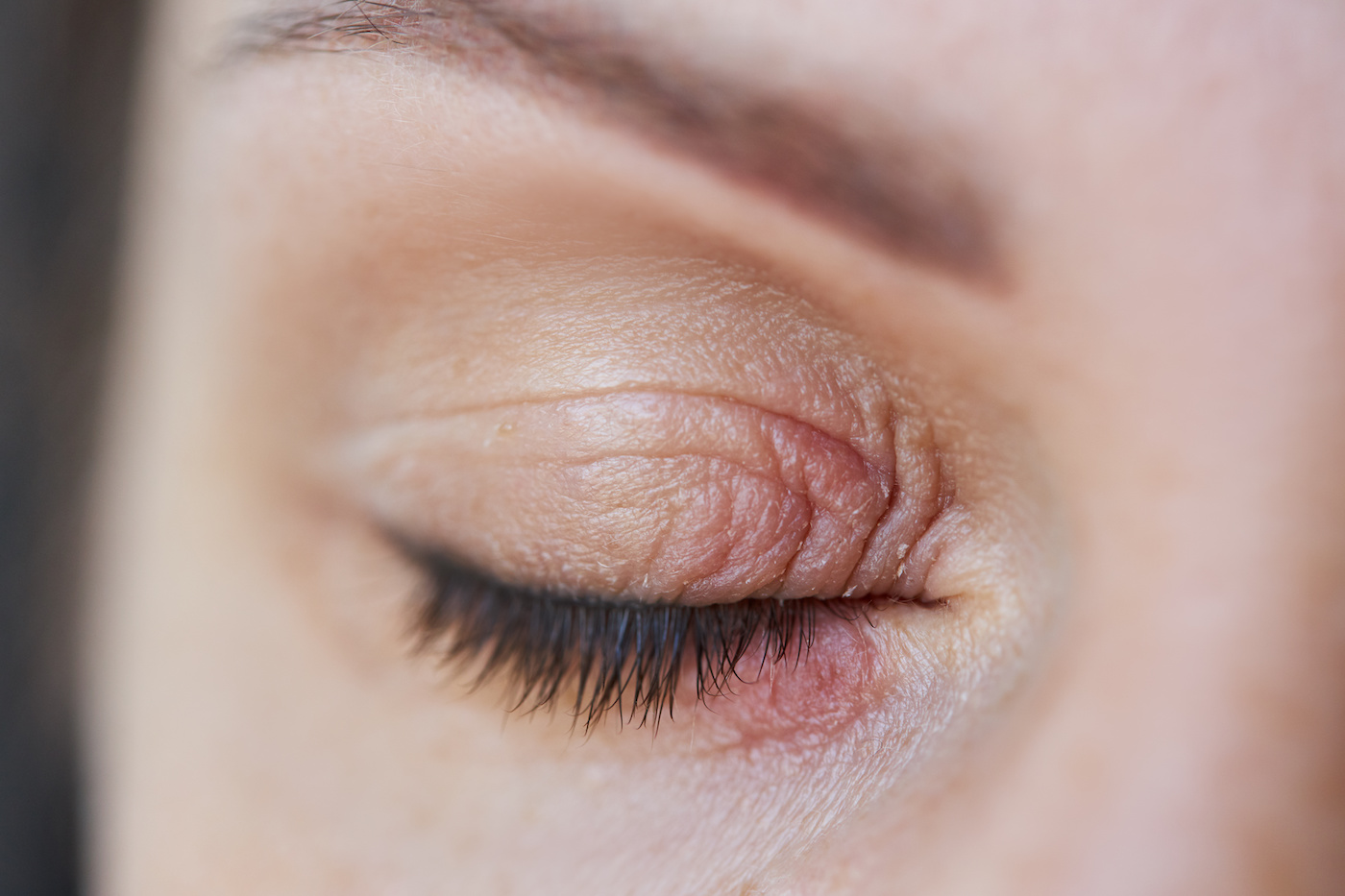
Leave a Reply
Learn More About Me
20 years of rosacea
- rosacea
- chronic skin issues
- gut issues
- food sensitivities
- inflammatory conditions
After 20 years of ineffective treatments and medications, Dr. O'Desky reversed her rosacea 100% through dietary changes and food-based medicine.
Health Coach & Holistic Skin Expert
Meet
Dr. Tara O'Desky
Since developing her own holistic healing program,
The Rosacea Method, she has helped countless patients of all ages with:
- rosacea
- chronic skin issues
- gut health
- food sensitivities
- inflammatory conditions
Dr. O'Desky continues to see patients in private practice in the USA and also sees clients via Telehealth. She currently offers various programs and workshops for people all over the world dealing with chronic health issues, poor gut health, and rosacea.
Health Coach and Holistic Skin Expert
Meet Dr. Tara O'Desky
-L. M.
"I want to say thank you so much for the program!
I never feel hungry anymore. My diet has opened up a ton and I feel really healthy and excited learning that there’s so many things I can eat now that are healthy and tasty. I felt good through the entire cleanse and my skin has definitely improved."
-Anonymous
"I felt so hopeless and I could not see light at the end of the tunnel. Now I have hope again and I feel more positive about my situation overall! Yes it can definitely heal, I have so so sure others heal! This program is great, I feel like It covers everything! Thank you! "
-Darlene B
"For the first time in 6 years, I feel like I have been given a clear direction to go in that will actually heal my skin. There's so much guess work that comes along with skin complications and Tara helps to clear all that up.Recommend 1000%."
Thank you for this detailed and very helpful information 🙏🏻
Thanks this was so informative and helped me have more understanding
So glad you enjoyed it!
Thank so much for this valuable information! You inspire me and make me not to give up the atempts to healing! I try, but i don’t have enough knowledge… continue research!
🙏
The doctors scrared me with demodex. I’m terrified. I don’t want to take all the medications offered. So happy to see that it’s possible to get over naturally.
Yes, tons of natural options!
Thank you for this!
Just found your blog, thank you for all the information
Pick me please! I’ve been wanting to start your program and just haven’t been able to💖
This blog is very interesting and helpful
I’m glad I found you.
Thanks for such a good summary of this and what I can do
You’re so welcome! You will heal!